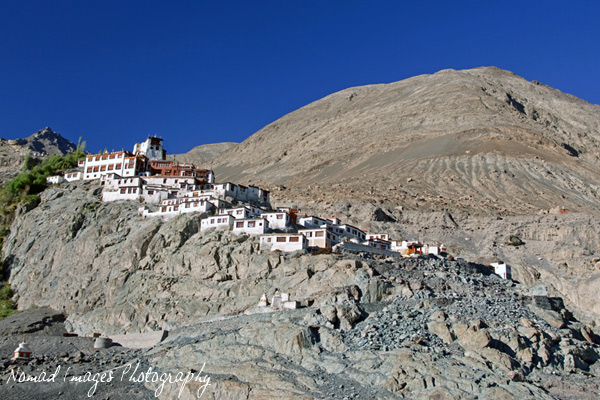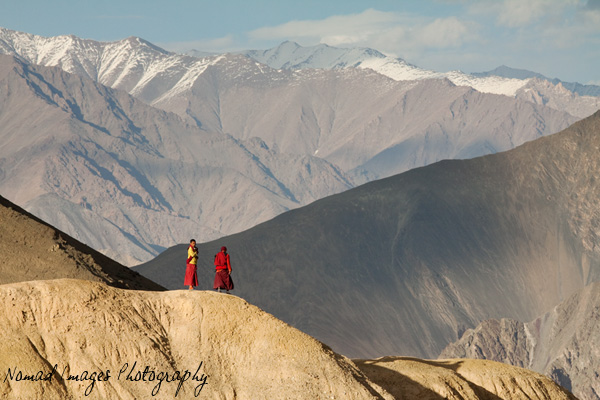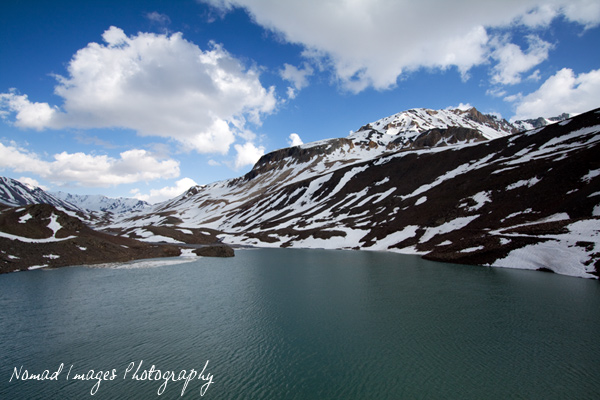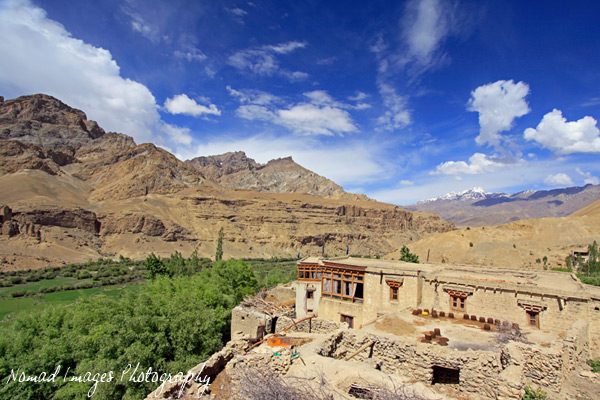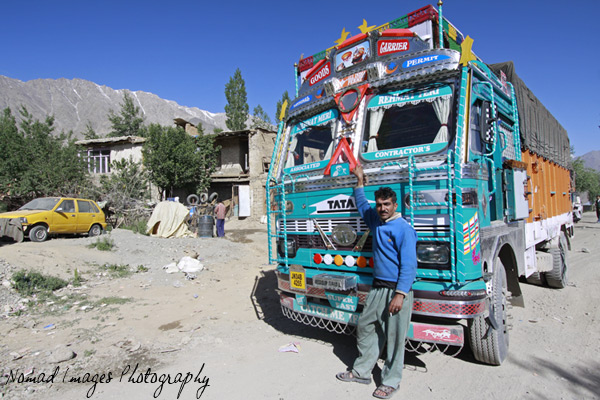Ladakh, Kashmir, India
Stereotypical Indian truck or 'king of the road' as they are often referred to venturing across the roof of the world in the high altitude desert region of Ladakh in the Indian Himalaya where the average altitude is around 12,000ft (3500m) above sea level.
Buddhist Gompa (monastery) at Mulbekh on the Srinagar - Leh highway
Ladakh part of Kashmir in the Himalayan range of northern India, is a wonder to behold.
I am aware of the wild and rugged beauty of say the Grand Canyon in the States (although I've never been but everyone knows about the place through its immense popularity and staring role in many a film), we have the beautific desolation of the Saharan desert (another world famous and earthly landmark) in Northern Africa, the lush and green jungles of the Amazon in South America popularised through film and by celebrities "wishing to appear to be doing their bit" for the long suffering tribes and the planet (naming no names!) And finally we arrive back to India, known the world over as a country being saturated with poverty and filth, with peoples engrossed in a million and one Gods and Goddesses and for, of course, the Taj Mahal.
Lord Buddha at Thiksey Gompa in Ladakh
Well I can tell you India is far more than that, you can find all the religions of the world there, poverty and wealth both physical and spiritual and beyond that a vast array of differing peoples and landscapes upon which they dwell.
Sunset in the Nubra Valley
Ladakh is one such place, a high altitude desert region with an altitude averaging 3500m or 12,000ft above sea level like neighbouring Tibet in China to the East. This is not only where the similarities are to be found 'next door' as it were. Its landscape is a continuation of Tibet, if borders were created based on landscape this area would be in Tibet along with Spiti valley (to the south of ladakh which also lies in indian territory).
17th Century Diskit Gompa in the Nubra Valley
As with Tibet the monasteries were strategically placed to afford the best possible view for contemplation and for protection, these gompas date back many centuries to when not only traders but warring tribes and bandits traversed the silk route.
The Majority of Ladakhs peoples are Buddhist as is obvious when one beholds such mind boggling structures as the monasteries (pictured above) perched high up on lofty precipes affording spectacular views of the valleys which they overlook. Perfect spots for meditation, contemplation and observing the workings of the mind whilst surrounded by some of the oldest visible geological rock formations on the planet and these rock formations are no ordinary rock formations but twisted and gnarled uprisings from the clash of landmasses millions of years ago which has created an unbelievable and stunning landscape.
Brave young monks scaling the himalayan heights
The Manali to Leh road in the himalayan region of north India which runs from Himachal Pradesh to Ladakh stretches 500km and covers a wide variety of mountainous terrain with stunning landscapes, vistas, unusual rock formations and snow covered mountain passes ranging from 4800m to 5300m above sea level. A journey to be marvelled at if travelling overland.
Scenery along the Manali - Leh Highway
At times you wonder where you are, "where on earth am I?" is a question I often found myself repeating, am I on the planet Mars or the moon even or some other undiscovered planet in the far reaches of the galaxy! The scenery is such that at times it is hard to mentally digest it but one thing is certain, it stimulates the mind and invokes a feeling of amazement, wonderment and awe at the earthly processes that occured to create such a natural wonder of our world.
Aerial View of the Capital Leh taken from Leh Palace
Little known Ladakh.....
Home to asian peoples (differing in race to Indians, yet classed as Indians), having there own Ladakhi language which is similar to Tibetan and living a lifestyle that is far removed from the way Indian people live down at sea level on the vast plains of mighty Bharat (India). The way of life is tough in this region where access is limited to several months of the year, the remainder finds the people snowed in as it were with the passes into the valley being blocked by vast snow drifts and ice. But Ladakhi's are resilient mountain folk who take it all in their stride, a tough but extremely friendly bunch, always helpful peaceful and hospitable.
Ladakhi woman turning a prayer wheel
The population density is so much less than the crowded and congested plains of India, the air is clean though lacking in oxygen for those that have not been there long at 12 to 14,000ft A.S.L. Altitude sickness for the newcomer is common, a given if you like wether you fly directly from down below or wether you take a couple of days to arrive by land on some form of transport travelling over numerous high altitude passes ranging from 3,000m to 5,400m above sea level. You will know you have arrived when you are short of breath and the headache ensues and the first few nights sleep are as restless as a monkey with its tail on fire.
Leh Gompa in the background
The houses of Ladakh blend beautifully into the surroundings being constructed of local natural materials. Clay bricks are handmade the traditional way by extracting the clay from the earth mixing it with water and straw for strengthening purposes before compressing it into a rectangular mould which is then left to dry in the sun. It's a cheap method of construction but has stood the test of time and along with wooden beams, window and door frames blends perfectly, even camouflaged amongst the ochre coloured landscape.
Ladakhi adobe at Mulbekh
Sunsets in Ladakh can be breathtaking when the ochre coloured mountains look absolutely resplendent. The colour is simply mesmerising and something that a painter would be proud to replicate. And this is yet another facet of Ladakh that makes it a phenomenal place to visit. The contrast of colours in this high altitude desert are amazing especially during sthe spring and summer months when the skies are clear and deep blue, the mountains around 6000m in height are laden with perpetual snow and the towns and villages situated along the great river Indus are not too disimilar to oasis with an over abundance of foliage of which the tall and majestic poplar tree plays a dominant role.
Oasis style scenery at Saspol
Ladakh was off the beaten track some years ago but as time goes on it is becoming an increasingly popular destination for not only foreign tourists but also for Indian tourists. The passes for road traffic open around June until september/october and the main tourists invasion occurs during the month of june for Indian tourists when the kids are on their school holidays and during july/august when foreign tourists start arriving due to their annual holiday period. Either way, the climate at these times of year, outside of the ice cold winter months is perfect reaching 30 degrees and above by day and neither to hot nor too cold at night.
Lamayuru - life below the Gompa
If trekking is your thing there are a multitude of travel agents in the capital city of Leh who will be willing to help and if you want to do a trek independantly then get yourself a good map and hit the road, there are a number of homestays in lesser known valleys where you can find a bed and have home cooked meals at reasonable prices.
Transport is by way of taxi, shared or unshared and local buses which are'nt too frequent or by doing as I did most of the time and that is hitching. It is a normal thing to do what with the terrain being so difficult and transport options being limited. Passing cars or Indian truck drivers are always good for a lift and not only helpful to outside visitors but it's also the done thing with locals alike. For me it was very much appreciated and some of the best travelling moments I have experienced.
Kashmiri Trucker
To be going over a 3650m pass in the dark, travelling in the cab of an Indian truck carrying 15 ton of cement and lurching from side to side as it traversed the uneven surface of a winter battered road with a fear of going over the edge on one of the switchbacks, whilst the drivers assistant cooked rice on a hob connected to a butane gas cylinder was a once in a lifetime experience. We passed through snow fields, through walls of snow reaching 20ft either side of us not knowing if we would make it or not, after all the pass was only recently opened and still not free of ice, of course it was dangerous!
But we did make it and stopped for rice and subzi (vegetables) when we eventually got down the other side and of course the complimentary glass of indian chai (tea) to celebrate before turning in for the night and wondering what would encounter us on the road the following day.
On the road to Leh and the Zoji La (pass)
Who needs fairground white knuckle rides when you can do this on the roof of the world for free........




